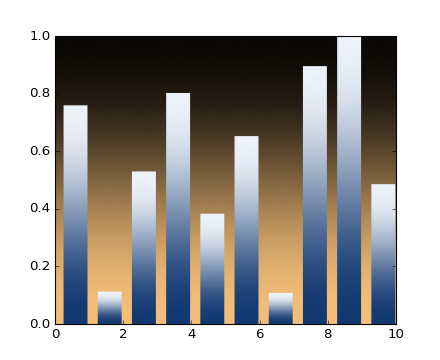
Learn what to expect in the new updates

(Source code, png, hires.png, pdf)

from matplotlib.pyplot import figure, show, cm
from numpy import arange
from numpy.random import rand
def gbar(ax, x, y, width=0.5, bottom=0):
X = [[.6, .6], [.7, .7]]
for left, top in zip(x, y):
right = left + width
ax.imshow(X, interpolation='bicubic', cmap=cm.Blues,
extent=(left, right, bottom, top), alpha=1)
fig = figure()
xmin, xmax = xlim = 0, 10
ymin, ymax = ylim = 0, 1
ax = fig.add_subplot(111, xlim=xlim, ylim=ylim,
autoscale_on=False)
X = [[.6, .6], [.7, .7]]
ax.imshow(X, interpolation='bicubic', cmap=cm.copper,
extent=(xmin, xmax, ymin, ymax), alpha=1)
N = 10
x = arange(N) + 0.25
y = rand(N)
gbar(ax, x, y, width=0.7)
ax.set_aspect('auto')
show()
Keywords: python, matplotlib, pylab, example, codex (see Search examples)